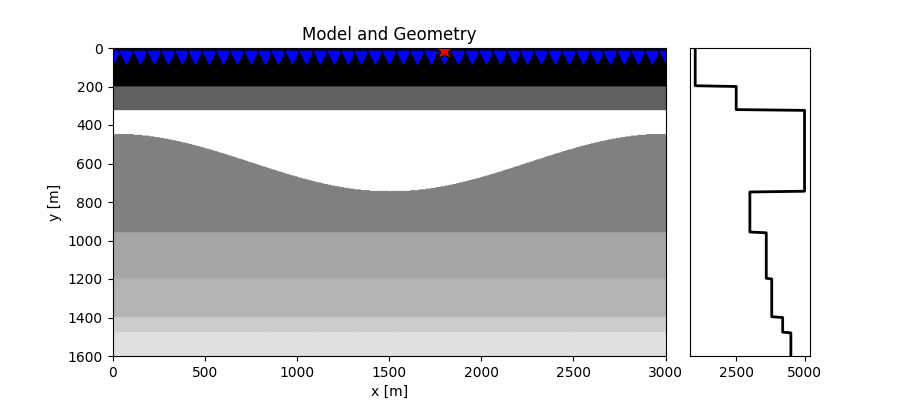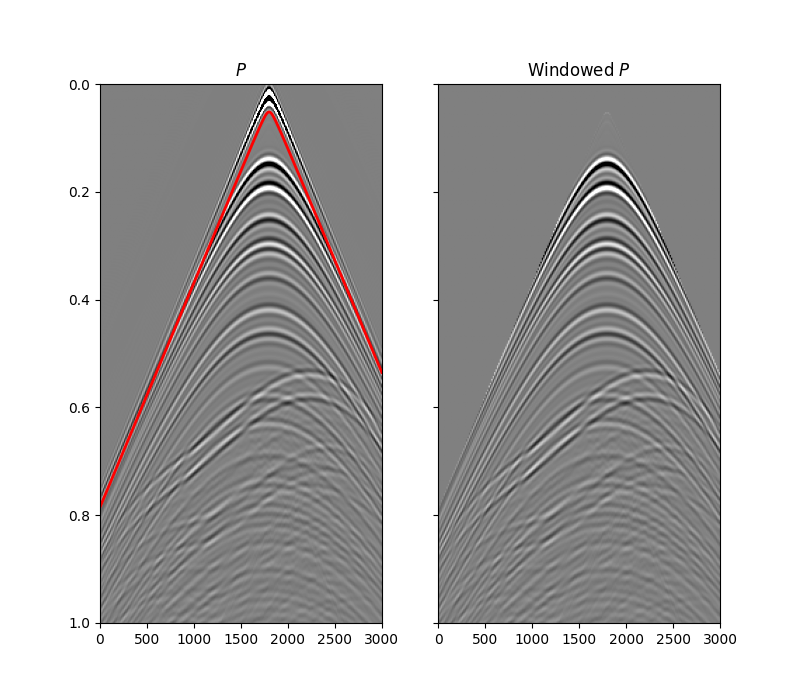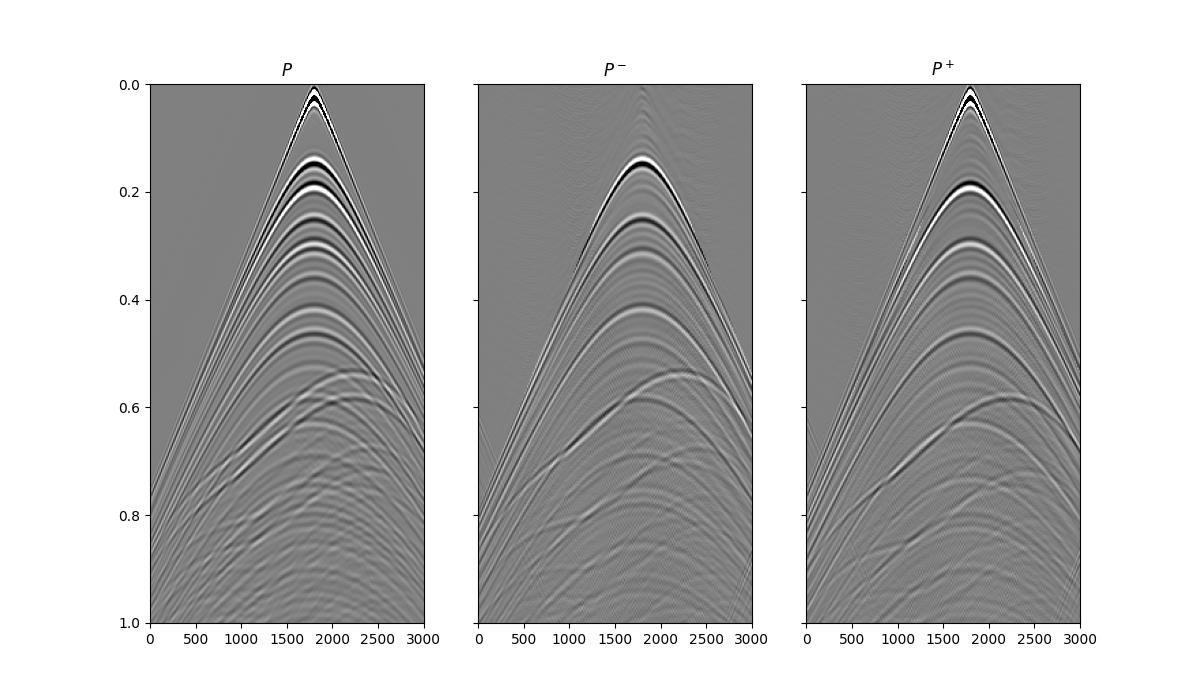Note
Click here to download the full example code
13. Deghosting¶
Single-component seismic data can be decomposed
in their up- and down-going constituents in a model driven fashion.
This task can be achieved by defining an f-k propagator (or ghost model) and
solving an inverse problem as described in
pylops.waveeqprocessing.Deghosting.
Let’s start by loading the input dataset and geometry
inputfile = '../testdata/updown/input.npz'
inputdata = np.load(inputfile)
vel_sep = 2400.0 # velocity at separation level
clip = 1e-1 # plotting clip
# Receivers
r = inputdata['r']
nr = r.shape[1]
dr = r[0, 1]-r[0, 0]
# Sources
s = inputdata['s']
# Model
rho = inputdata['rho']
# Axes
t = inputdata['t']
nt, dt = len(t), t[1]-t[0]
x, z = inputdata['x'], inputdata['z']
dx, dz = x[1] - x[0], z[1] - z[0]
# Data
p = inputdata['p'].T
p /= p.max()
fig = plt.figure(figsize=(9, 4))
ax1 = plt.subplot2grid((1, 5), (0, 0), colspan=4)
ax2 = plt.subplot2grid((1, 5), (0, 4))
ax1.imshow(rho, cmap='gray', extent=(x[0], x[-1], z[-1], z[0]))
ax1.scatter(r[0, ::5], r[1, ::5], marker='v', s=150, c='b', edgecolors='k')
ax1.scatter(s[0], s[1], marker='*', s=250, c='r', edgecolors='k')
ax1.axis('tight')
ax1.set_xlabel('x [m]')
ax1.set_ylabel('y [m]')
ax1.set_title('Model and Geometry')
ax1.set_xlim(x[0], x[-1])
ax1.set_ylim(z[-1], z[0])
ax2.plot(rho[:, len(x)//2], z, 'k', lw=2)
ax2.set_ylim(z[-1], z[0])
ax2.set_yticks([], [])

Out:
[]
To be able to deghost the input dataset, we need to remove its direct arrival. In this example we will create a mask based on the analytical traveltime of the direct arrival.
direct = np.sqrt(np.sum((s[:, np.newaxis]-r)**2, axis=0))/vel_sep
# Window
off = 0.035
direct_off = direct + off
win = np.zeros((nt, nr))
iwin = np.round(direct_off/dt).astype(np.int)
for i in range(nr):
win[iwin[i]:, i] = 1
fig, axs = plt.subplots(1, 2, sharey=True, figsize=(8, 7))
axs[0].imshow(p.T, cmap='gray', vmin=-clip*np.abs(p).max(),
vmax=clip*np.abs(p).max(),
extent=(r[0, 0], r[0, -1], t[-1], t[0]))
axs[0].plot(r[0], direct_off, 'r', lw=2)
axs[0].set_title(r'$P$')
axs[0].axis('tight')
axs[1].imshow(win * p.T, cmap='gray', vmin=-clip*np.abs(p).max(),
vmax=clip*np.abs(p).max(),
extent=(r[0, 0], r[0, -1], t[-1], t[0]))
axs[1].set_title(r'Windowed $P$')
axs[1].axis('tight')
axs[1].set_ylim(1, 0)

Out:
(1.0, 0.0)
We can now perform deghosting
pup, pdown = \
pylops.waveeqprocessing.Deghosting(p.T, nt, nr, dt, dr, vel_sep,
r[1, 0] + dz, win=win,
npad=5, ntaper=11, solver=lsqr,
dottest=False, dtype='complex128',
**dict(damp=1e-10, iter_lim=60))
fig, axs = plt.subplots(1, 3, sharey=True, figsize=(12, 7))
axs[0].imshow(p.T, cmap='gray', vmin=-clip * np.abs(p).max(),
vmax=clip * np.abs(p).max(),
extent=(r[0, 0], r[0, -1], t[-1], t[0]))
axs[0].set_title(r'$P$')
axs[0].axis('tight')
axs[1].imshow(pup, cmap='gray', vmin=-clip * np.abs(p).max(),
vmax=clip * np.abs(p).max(),
extent=(r[0, 0], r[0, -1], t[-1], t[0]))
axs[1].set_title(r'$P^-$')
axs[1].axis('tight')
axs[2].imshow(pdown, cmap='gray', vmin=-clip * np.abs(p).max(),
vmax=clip * np.abs(p).max(),
extent=(r[0, 0], r[0, -1], t[-1], t[0]))
axs[2].set_title(r'$P^+$')
axs[2].axis('tight')
axs[2].set_ylim(1, 0)
plt.figure(figsize=(14, 3))
plt.plot(t, p[nr // 2], 'k', lw=2, label=r'$p$')
plt.plot(t, pup[:, nr // 2], 'r', lw=2, label=r'$p^-$')
plt.xlim(0, t[200])
plt.ylim(-0.2, 0.2)
plt.legend()
plt.figure(figsize=(14, 3))
plt.plot(t, pdown[:, nr // 2], 'b', lw=2, label=r'$p^+$')
plt.plot(t, pup[:, nr // 2], 'r', lw=2, label=r'$p^-$')
plt.xlim(0, t[200])
plt.ylim(-0.2, 0.2)
plt.legend()
Out:
<matplotlib.legend.Legend object at 0x7f835941dda0>
To see more examples head over to the following notebook: notebook1.
Total running time of the script: ( 0 minutes 7.043 seconds)


